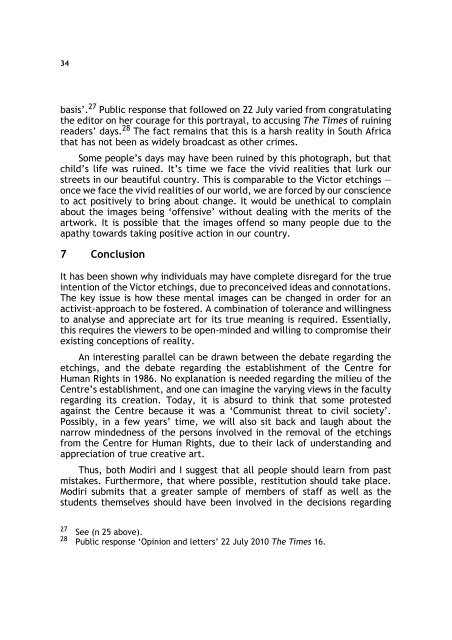Download this publication - PULP - University of Pretoria
Download this publication - PULP - University of Pretoria
Download this publication - PULP - University of Pretoria
You also want an ePaper? Increase the reach of your titles
YUMPU automatically turns print PDFs into web optimized ePapers that Google loves.
34<br />
basis’. 27 Public response that followed on 22 July varied from congratulating<br />
the editor on her courage for <strong>this</strong> portrayal, to accusing The Times <strong>of</strong> ruining<br />
readers’ days. 28 The fact remains that <strong>this</strong> is a harsh reality in South Africa<br />
that has not been as widely broadcast as other crimes.<br />
Some people’s days may have been ruined by <strong>this</strong> photograph, but that<br />
child’s life was ruined. It’s time we face the vivid realities that lurk our<br />
streets in our beautiful country. This is comparable to the Victor etchings —<br />
once we face the vivid realities <strong>of</strong> our world, we are forced by our conscience<br />
to act positively to bring about change. It would be unethical to complain<br />
about the images being ‘<strong>of</strong>fensive’ without dealing with the merits <strong>of</strong> the<br />
artwork. It is possible that the images <strong>of</strong>fend so many people due to the<br />
apathy towards taking positive action in our country.<br />
7 Conclusion<br />
It has been shown why individuals may have complete disregard for the true<br />
intention <strong>of</strong> the Victor etchings, due to preconceived ideas and connotations.<br />
The key issue is how these mental images can be changed in order for an<br />
activist-approach to be fostered. A combination <strong>of</strong> tolerance and willingness<br />
to analyse and appreciate art for its true meaning is required. Essentially,<br />
<strong>this</strong> requires the viewers to be open-minded and willing to compromise their<br />
existing conceptions <strong>of</strong> reality.<br />
An interesting parallel can be drawn between the debate regarding the<br />
etchings, and the debate regarding the establishment <strong>of</strong> the Centre for<br />
Human Rights in 1986. No explanation is needed regarding the milieu <strong>of</strong> the<br />
Centre’s establishment, and one can imagine the varying views in the faculty<br />
regarding its creation. Today, it is absurd to think that some protested<br />
against the Centre because it was a ‘Communist threat to civil society’.<br />
Possibly, in a few years’ time, we will also sit back and laugh about the<br />
narrow mindedness <strong>of</strong> the persons involved in the removal <strong>of</strong> the etchings<br />
from the Centre for Human Rights, due to their lack <strong>of</strong> understanding and<br />
appreciation <strong>of</strong> true creative art.<br />
Thus, both Modiri and I suggest that all people should learn from past<br />
mistakes. Furthermore, that where possible, restitution should take place.<br />
Modiri submits that a greater sample <strong>of</strong> members <strong>of</strong> staff as well as the<br />
students themselves should have been involved in the decisions regarding<br />
27 See (n 25 above).<br />
28 Public response ‘Opinion and letters’ 22 July 2010 The Times 16.

















